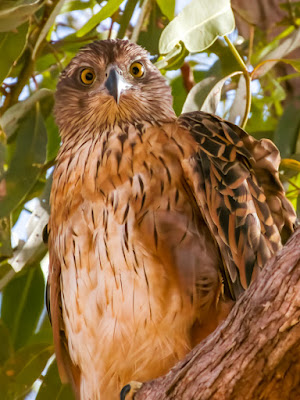Check my birding map for specific location.Musgrave is the furthest north I have been on Cape York. Actually, I made it about 40km north of the roadhouse before turning back. I had hoped to get to Weipa on the west coast but as well as being very wild, the roads are terrible to drive on. I was the only 2wd vehicle or campervan on the road and I could feel the waves of disbelief heading my way from the big 4wd utes and trucks around me. I didn't think I was on a fools errand as everyone I spoke to thought I could make it to Weipa.
Cape York is the wildest place I have been to in Australia. Its like the jungle meets the Outback. There is a plethora of wildlife here from dingo, roos to birds. It is also stunningly beautiful. I loved driving through it where the road was sealed but where the road was not sealed, it was terrifying. While the road remains wide, it changes rapidly from sand to gravel to patches of old concrete. As well as contending with the infamous corrugations, there are areas of debris, dust holes and sudden changes from one to another. On top of that is the never ending dust that means I have to strip the van to clean it when I get back onto solid ground. It is not a place for a campervan with a high centre of gravity and a water tank slung underneath.

I made it to Musgrave in good time and was pleasantly surprised at the quality of the Roadhouse and caravan park. I stayed there overnight and spent the day sitting next to the dam. Not too close, however, there were warning signs about crocodiles everywhere. These were Freshwater Crocodiles, smaller than their terrifying Saltwater cousins. Australians are much less afraid of Freshies and while they are apparently smaller and less likely to attack, I found them to be equally as sinister. I counted 9 animals floating in the water and on the bank. As darkness fell, I moved the van away from the water's edge.
Freshwater Crocodile (Crocodylus johnsoni)
I spent some time chasing the rather delightful Large-billed Gerygone as it flitted from branch to branch overhanging the water. In New Zealand, the endemic gerygone is the Grey Warbler and I always associate this active little birds with singing. This species is no exception and I am always amazed at the loudness of their vocals.
Large-billed Gerygone (Gerygone magnirostris)
A friend of mine had spent some time in the area and gave me the location of nesting Red Goshawks. I spent some time driving a back road (thankfully of good quality) and found the inactive nest easily. Disheartened, I sat in the van and waited to see if the birds were still around. Loud screeching indicated their return after some time. The female briefly inspected the nest before taking off again. The male, however, put on a great display as it sat above me dismembering a Rainbow Lorikeet. It was quite a sight.
Red Goshawk (Erythrotriorchis radiatus)
Emu (Dromaius novaehollandiae)
On my return south, I stopped in at Artemis Station to try to see the Golden-shouldered Parrots again. I was rewarded with a fantastic sighting of a male, sitting and preening.
Golden-shouldered Parrot (Psephotus chrysopterygius)
In my experience, Cape York is the wildest place in Australia and I hope to get back to explore further.
eBird List


















